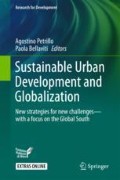Abstract
During the last decades, emerging global commodity chains have been re-shaping local growth and shrinkage processes, by linking far away consumers and producers. Regional transformations are complex and long-term phenomenon lead by the interplay of forces acting from and at different scales. This paper explores the teleconnections’ local implications embedded within the Southern Bolivian Altiplano transition, from being a remote rural area of subsistence farming to a global leading quinoa cropping market driven territory. The essay identifies lessons that are likely to be relevant for increasing adaptive capacity, fostering sustainability solutions, avoiding unsustainability lock-ins by the relationship between cereal market at the national scale, an uncontrolled growth of a specific crop (quinoa) and community actions in the Southern Bolivian Altiplano.
Access this chapter
Tax calculation will be finalised at checkout
Purchases are for personal use only
References
Chelleri L, Waters JJ, Olazabal M et al (2015) Resilience trade-offs: addressing multiple scales and temporal aspects of urban resilience. Environ Urban 27(1):181–198
Chelleri L, Minucci G, Skrimizea E (2016) Does community resilience decrease social–ecological vulnerability? Adaptation pathways trade-off in the Bolivian Altiplano. Reg Environ Change 16:2229–2241
Cramer W (2002) A new look at regional environmental change. Reg Environ Change 3(1–3):1
Elmqvist T, Fragkias M, Goodness J et al (2013) Urbanization, biodiversity and ecosystem services: challenges and opportunities. Springer, Dordrecht
Erb KH, Krausmann F, Lucht W et al (2009) Embodied HANPP: mapping the spatial disconnect between global biomass production and consumption. Ecol Econ 69:328–334
Félix D, Villca C (2009) Quinua y territorio. Experiencias de acompañamiento a la gestión del territorio y a la autogestión comunal en la zona Intersalar del altiplano boliviano. Agronomes and Vétérinaires sans frontiéres, 156 pp
Heran V (2011) L’Altiplano Sud de Bolivie dans la mondialisation agricole: Quelles solutions pour une production durable de quinoa? Cas des communautés du municipio de Tomave, département de Potosí. Dissertation, École supérieure d’Agro-développement International
Hill M, Allan A (2013) Adaptive capacity in a Chilean context: a questionable model for Latin America. Environ Sci Policy 43:78–90
Joffre R, Acho J (2008) Quinua, descanso y tholares en el sur del Altiplano Boliviano. Revista Habitat 75:38–43
Lauer M, Albert S, Aswani S et al (2013) Globalization, Pacific islands, and the paradox of resilience. Glob Environ Change 23(1):40–50
Lidema (2008) Estado Ambiental de Bolivia 2007-2008, Soipa Lida, La Paz (Bolivia)
Martin C (2012) Migración en el Sur Boliviano. Contrastes entre valles andinos tradicionales y áreas orientales de colonización. SM gráficos, Mexico
Ministerio de Desarrollo Rural y Tierras, Reporte 22.08.2016. http://www.ruralytierras.gob.bo/
Mulligan M, Steele W, Rickards et al (2016) Keywords in planning: What do we mean by ‘community resilience’? Int Plann Stud 1–14
PIEB—Programa de Investigación Estratégica en Bolivia (2010) Programa de Investigación Ambiental Producción de quinua en Oruro y Potosí. Programa de Investigación Ambiental. Fundación PIEB, La Paz
Seitzinger S, Svedin U, Crumley C et al (2012) Planetary stewardship in an urbanizing world: beyond city limits. Ambio 41(8):787–794
Seto KC, Reenberg A, Boone CG et al (2012) Urban land teleconnections and sustainability. Proc Natl Acad Sci 109(20):7687–7692
Sillitoe P (2002) Participating in development: approaches to indigenous knowledge. Routledge
UGRP—Unidad de Gestión de Riesgos de la Gobernacion del Departamento Autonomo de Potosí (2010) Plan De Contingencia Para La Altiplano De Potosí-Bolivia
Vargas Ramirez R (2012) Evaluación de fin de Proyecto:Integración productiva de camélidos y quinua en Tomave (Potosí). ANE/2009/227-642
Vassas Toral A (2011) Ruralité et agriculture au prisme des mobilités spatiales. L’Altiplano Sud de la Bolivia à l’heure du boom de la quinoa. Dissertation, Université Paul Valéry Montpellier III
Young OR, Berkhout F, Gallopin GC et al (2006) The globalization of socio-ecological systems: an agenda for scientific research. Glob Environ Change 16(3):304–316
Author information
Authors and Affiliations
Corresponding author
Editor information
Editors and Affiliations
Rights and permissions
Copyright information
© 2018 Springer International Publishing AG
About this chapter
Cite this chapter
Minucci, G. (2018). Social–Ecological Implications of the Quinoa Market Teleconnections: Intervention Criteria on the Southern Bolivian Altiplano. In: Petrillo, A., Bellaviti, P. (eds) Sustainable Urban Development and Globalization. Research for Development. Springer, Cham. https://doi.org/10.1007/978-3-319-61988-0_28
Download citation
DOI: https://doi.org/10.1007/978-3-319-61988-0_28
Published:
Publisher Name: Springer, Cham
Print ISBN: 978-3-319-61987-3
Online ISBN: 978-3-319-61988-0
eBook Packages: Earth and Environmental ScienceEarth and Environmental Science (R0)

